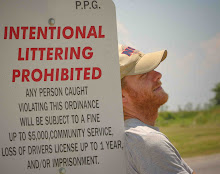I began hearing about the “Basin Street Corridor” after only a few days of being down here. Most people who use the phrase are developers and the planners or architects who work for them.
In the context of post-Katrina New Orleans the Basin Street Corridor refers to a zone of particularly important real estate that many now feel is up for grabs. It’s important land because it sits on the edge of the French Quarter and connects the I-10 freeway to Canal Street. One developer summed up its importance by noting that the only exit sign for the “French Quarter” on the entire freeway through New Orleans leads motorists down an off ramp and onto Basin Street – the “Corridor.” From here they can drive to Canal Street or turn left into the French Quarter. From here on it’s all “laissez le bon temps roule!”
Combined, the French Quarter and Canal Street are at the core of the tourist economy. Hundreds of millions of dollars are made off of conventions, gambling, food, hotels, and alcohol sales in this relatively small geographic area. Moguls of the industry believe that this number could one day inflate to billions, but that requires drastic changes in the cityscape.
If you’re a real estate capitalist, a hotel owner, or anyone with an economic imperative to increase property values and “Disneyfy” the Canal Street/French Quarter area the Basin Street Corridor has one fatal flaw. It’s called public housing. It’s populated mostly by poor and working class blacks. Nearly all of the low-income housing in the Basin Street Corridor is contained in the Iberville public housing project.
Built in 1941, the Iberville wasn’t always a thorn in the side of the New Orleans growth machine. In fact, when it was built the Iberville replaced the Storyville district. It was an all white public housing project and the construction of it allowed city leaders to demolish a largely poor black community – a community they deemed a slum – and banish its inhabitants to less valuable, less central real estate.
But the Iberville eventually became an all black project. Legal scholar Martha Mahoney says that the process was not purely a matter of white flight after public housing was integrated. Rather, housing and job discrimination that locked blacks out of the suburbs and left them structurally un/underemployed mean that while whites easily transitioned out of public housing at higher rates than they entered it, blacks were stuck (it’s important to point out, however, that even though many black residents were stuck in public housing, they remained productive and responsible citizens. The notion that the projects are “black-holes” of economic and social hopelessness is patently false. The projects have their problems, but they are still vital communities).
Thus racism and structural unemployment created New Orleans’ public housing ghettos. Many Iberville residents did manage to gain employment in and around the downtown in spite of the enormous barriers they faced. But the projects eventually became what they are; harsh environments with high unemployment rates and endemic drug and crime problems.
Downtown elites have big plans for Central Business District, French Quarter, Canal Street, and Warehouse District. They believe that transforming the Basin Street Corridor is a prerequisite to realizing these plans. They are well on their way to realizing this goal.
Read my recent post on New Orleans Indymedia for the rest of the story….
http://neworleans.indymedia.org/news/2006/08/8343.php
Subscribe to:
Post Comments (Atom)

No comments:
Post a Comment